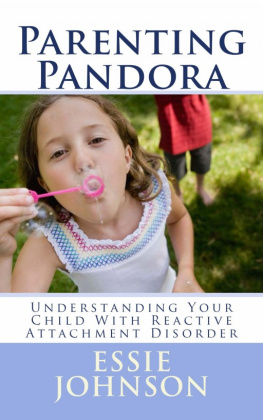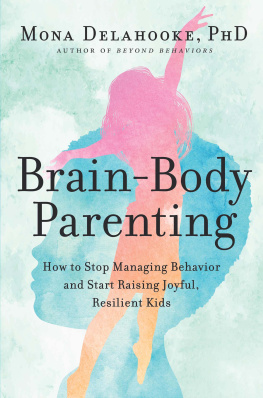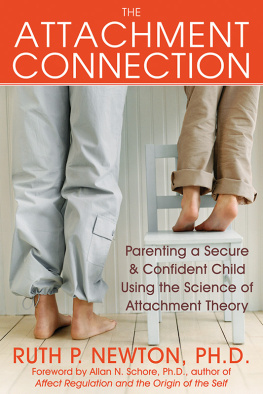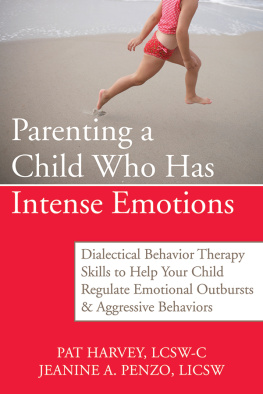PARENTING PANDORA
Understanding Your Child With ReactiveAttachment Disorder
By Essie Johnson
Copyright 2014 Essie Johnson
Amazon Edition, LicenseNotes
This book remains the copyrightedproperty of the author, and may not be redistributed to others forcommercial or non-commercial purposes. Thank you for yoursupport.
Table of Contents
Chapter 10 Suggestionsfor School
FinalWord s 53
Disclaimers 55
The story of Pandoras Box comes from Greekmyth ology. Pandora was created by the godsto have the best of everything, to be all gifted. When shemarried, she received a beautiful box. She innocently opened it,only to release the evils of the world. In the end, all thatremained in the box was hope.
In 2007, my husband and I adopted alittle girl who was just 4 years old. She would join our biologicaldaughter, who was 2.
Genea was born in Ukraine and lived inan orphanage until she was adopted and brought to the United Statesby a couple for whom she would be their first child. She lived withthem for the next two and a half years as they tried, withoutsuccess, to help her.
The biggest issue as they saw it, wasthat she was miserable. Severely withdrawn- except for screamingfits- she even disassociated at times. They sought help, but felttherapists and doctors blamed them. Their marriage fell apart andthey began to search for another family to adopt her.
My husband and I met Genea andimmediately adored her. She was happy and always excited to see us.A beautiful child, the type to elicit compliments from even themost cantankerous elder. She and our biological daughter becamelife -long sisters the day they met, and we proceeded with theadoption.
Following several months of visits,both families met at a fast food restaurant one last time. Geneawas her usual self; bouncy, charming, happy. She was indifferent tothe mother, which was normal, and their final goodbye was swift andeasy.
Taking my new set of daughters home, Iput them both down for a nap. I did not see that happy, delightfulchild again for four years.
Volcanic explosions, unending tantrums,rages at an intensity that made me wonder if a small child couldcause herself an aneurism. That a tiny little girl could createthis whirlwind of chaos was incomprehensible. I thought I knewexhaustion. I thought I knew frustration and I thought I knewanger. I did not. Left in the literal puddles of spit she sprayedwhile shrieking, was everything I thought I knew about parenting,and myself as well.
The next several years were spenttrying to understand what was happening. It was like living in theGravitron ride at a carnival. Whirling faster and faster,immobilized, plastered to the wall by centrifugal force.
Seven years later, I do not have allthe answers but I have found a few. This booklet is my attempt toshare what I have learned.
Reactive Attachment Disorder is a severe disruption oftypical development, resulting in a child unable to bond. However,it is much more than that.
Children affected have developedextreme emotional reactions that can be extraordinarily difficultto live with, sometimes even impossible. The things they think ofto do are unbelievable. The incessant mental battering and constantintensity are exhausting. They can be volatile, violent, andhateful.
At the same time, they arechildren. Children who have had no base to structure themselvesaround, and who can get better.
Raising a child with RAD is likely themost challenging thing we have ever done. Typical parentingtechniques do not work. Our children might take one step forwardonly to regress to a point more difficult than where theystarted.
Despite sometimes counting the daysuntil they turn eighteen, we love them. We want them to love us andlove life. We want them to be healthy and happy. We wonder howwell react the first time police come to our door and we pray ourchildren dont hurt anyone besides ourselves.
This mini book contains a few of thethings that have helped make things better in my family.
No one should have to live as theydo.
I believe the driving forcebehind most Reactive Attachment Disordered behavior is the need tocreate predictable situations. The obsession with control and thecompulsion to constantly manipulate circumstances reduces feelingsof fear. They dont seek love to replace fear, they seek predictability to control fear.
Safety is the second tier in MaslowsHierarchy of Needs. The first tier is physiological and includesbreathing, food, sleep, and homeostasis (the unconscious drive tostay the same). When those needs are met, the person focuses onsafety. Until a person feels safe, they cannot move up to thelevels of love, self-esteem and self-actualization.
The child with RAD feelsconstantly unsafe. Even when they are safe in a stable and lovingenvironment, the dangers that were burned into their brains frominfancy are a constant buzz in the background. This could well bewhy love is not enough.
Children with RAD exists ononly 2 planes- now , and next. The past is not relevant, it cant help them anymore. Thefuture is equally irrelevant. There is no trust that existingsafety will continue. They care about what is happening right now,and what immediately follows.
When they do not know whatis coming they feel anxiety that increases from minute to minute.They manipulate in order to make what happens next be what they predict will happennext.
Years ago, my daughterwould come home from kindergarten and every day immediatelyescalate into a level 10 meltdown. Always standing in the same spotin the middle of the hallway, she began with a provoking questionfor something she knew she could not have. When the answer was no,she commenced with a shrieking meltdown. I ignored it to see if shemight calm down. She never did. I would tell her what TO do, likestandard parenting experts recommend, Calm down honey . She did not. Thencame the warning- calm down or youllhave to take a time out in your room .Wait a few more minutes (she never calmed down with the warningeither), and send her to her room.
I was as consistent as possible and yetevery single day was the same. Traditional parenting is dependenton consistency. Always issue a firm consequence for unwantedbehavior. Any deviation will cause the behavior to repeat. But herewas the complete opposite. I was being as consistent as anyonecould be yet the behavior did not stop, or even slowdown.
It appeared she had no sense of causeand effect. Having this tantrum every day meant going to her room.She hated going to her room. Logically, she should stop thetantrums to stay out of her room.
Its embarrassing how longit took me to realize what was happening. She was rigidly doing thesame thing every day so I would issue the same consequence. She hadlearned cause and effect alright, just not in the traditional way.Her escalating behavior after school was actually a series ofmanipulated steps to push me to react the same way I always did-predictably. She was causing with her behavior theeffect of my reactions. It was what shewanted all along.
The consequences of going to her roomand having her family frustrated with her could not compare to thestrength of her need to reduce the fear of what might happenotherwise.
Here lies one of the most difficultparts of having a child with RAD. Trying to use motivators orconsequences to change their behavior is not likely to work. Verylittle is more valuable to her than feeling safe. Threatening hersafety to compel a change in behavior is not just unfair, it willbackfire. She will become even more scared and her behavior will bemore manipulative. Additionally, once you have gone there, shewill compulsively push you to go there again- forcing thepredicted reaction.
What Might Work:
Be inconsistent with problem behavior,and use rock solid consistency with behavior you want to seerepeated.










